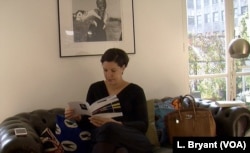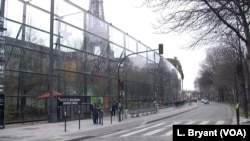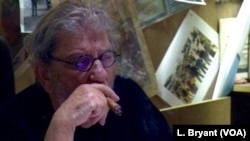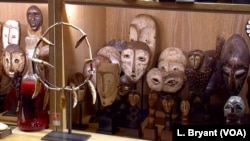In the 19th century, the Kingdom of Dahomey was a major West African power, boasting a flourishing slave trade with Europe and a feared corps of Amazon women warriors. Commissioned by the royal court, its art — intricate wood and ivory carvings, metalwork and appliqué cloth — stood as a potent symbol of the kingdom’s might.
But by 1894, Dahomey was annexed by France after a pair of brutal wars. Its artifacts ended up in French museums and private collections.
Now modern-day Benin, the seat of the former Dahomey kingdom, may have the best chance to date of getting them back, as French President Emmanuel Macron vows to make the return of treasures from former African colonies a top priority. That vow will be tested next week, when Benin President Patrice Talon visits France. Restitution of Dahomey artifacts is expected to rank high in (March 6) discussions between the two leaders.
“The question is to give back what has been stolen during the worst conditions of war,” said Marie-Cecile Zinsou, daughter of Benin’s former prime minister and president of the Zinsou Foundation, an organization in the main city, Cotonou, that promotes African art.
“It’s very small for France, but for us it’s everything,” she said of the roughly 5,000 artifacts Benin wants back. “We have nothing left in Benin — we have copies, but no original trace of our history.”
Made during a November speech in Burkina Faso's capital, Ouagadougou, Macron’s restitution promise has been described as historic and even revolutionary. Over the next five years, he said, the conditions must be met ‘for the temporary or permanent restitution of African heritage to Africa.”
“African heritage can’t just be in European private collections and museums,” Macron said. “African heritage must be highlighted in Paris, but also in Dakar, in Lagos, in Cotonou.”
Experts believe that if realized, France’s example may prove the tipping point for other former colonial powers, similarly pressured by restitution claims. But while much of Africa’s cultural heritage lies outside the continent — stolen, sold or otherwise expatriated by European soldiers, missionaries and Africans themselves — returning it lays bare a tangle of difficult questions.
Who should receive artifacts that may have changed hands and borders many times over the years? Should private collections, as well as national museums be compelled to return the treasures? And would those returns be permanent or temporary? In France, repatriation may also demand changing current law that recognizes the artifacts as inalienable cultural heritage.
Skeptics argue that many African countries lack national museums or other spaces capable of housing old and fragile artifacts. And apart from a handful of exceptions like Benin, some say, few governments have mounted strong restitution campaigns.
“All these countries have so many problems to solve that it’s not been the priority,” according to Corinne Hershkovitch, a French lawyer specializing in the restitution of cultural goods. “But it has be be a priority if you want to make cultural heritage come back to your country.”
Others say restitution discussions are taking place outside the media spotlight. Many agree returning African art will demand creative ways of thinking and pooling resources.
“The debate has started in France,” said Mechtild Rössler, director of UNESCO’s World Heritage Center. “Museums now need to look at their own collection and identify pieces, which may have been trafficked illegally, or which may have come out of some dubious circumstances during colonialism. It’s part of reviewing the whole colonial history.”
The debate also heating is up in other European countries, which collectively house several hundred thousand African artefacts. That includes in Germany, where Berlin’s museum chief wants to draw up international museum guidelines for the repatriation of African artefacts — similar to those created for the return of Nazi-confiscated art.
In Britain, Cambridge University students are calling for a bronze cockerel on the university campus to be returned to Nigeria. It is among hundreds of ‘Benin bronzes’ looted during colonial days whose return will be discussed by European museums during a meeting this year. Restitution also will be on the menu at yet another conference being organized in Brazzaville.
“It’s a matter of justice and culture, but it’s also a matter of business,” said Louis-Georges Tin, head of CRAN, an umbrella group of black French associations that helped spearhead some of the repatriation demands. “You cannot do business with African countries and be a robber at the same time.”
For African countries, repatriating the artefacts carries another powerful economic argument, since they can attract sought-after tourism revenue. “Museums can be the first entry point to learn about the history and culture of these countries,” said UNESCO’s Rossler. “But there must also be different explanations than those given in Europe.”
Beyond restituting African artifacts, Rossler also said Europe could help African countries to house them.
“I have seen museums in Africa where this is absolutely possible,” she said, adding that in other cases, the European Union or individual countries may offer financing.
In France, the public Quai Branly Museum, which houses most of the country’s colonial-era African artifacts, says it is open to restitution demands — providing proper conditions and political will exist.
“We don’t return objects just to heal wounds,” Quai Branly’s president, Stephane Martin, told Paris Match magazine. “The people who receive them must have a real desire to do something with them.”
Others argue African countries should be making those calls.
“It’s our problem what to do with our heritage,” said Zinsou of the Benin foundation. “It’s not a question of France telling us what to do.”
In 2016, Benin became the first sub-Saharan African country demanding that France return its artifacts, arguing they were important both culturally and economically. But last year, the previous French government rejected that request, arguing the pieces now were legally French property. If the Macron administration gives the green light, it may demand changing French law.
“I hope Benin will show what is possible,” Zinsou said. “Even if you’re a poor country, you can [repatriate artifacts] properly.”
Restitution questions also are roiling private galleries and auction houses. But at his office near the Seine River, Paris gallery owner Robert Vallois is serene.
“The doors are open for discussion among people of good will,” he said.
Vallois and group of local gallery owners have offered one answer to the debate. In 2015, they opened a small museum in Benin that exhibits art donated from their own collections.
“Is it a national treasure for France, or is it a national treasure for Africa?” Vallois asked. “Both. The problem is to show it to the people.”












Facebook Forum